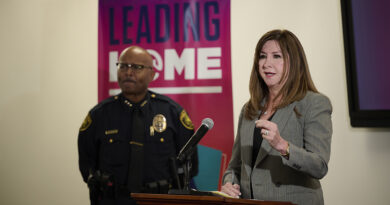Dallas ISD Fentanyl Prevention Focused on Awareness
Dallas ISD’s fentanyl-prevention efforts focus on education and awareness for students and families.
“We’re creating the awareness before it hits our schools,” Dallas ISD District 1 trustee Edwin Flores said.
Fentanyl and other drug prevention programming has included parent forums, school assemblies, and a website for families.
There are also measures if it becomes an issue.
Dallas ISD schools have licensed mental health counselors and staff members trained on NARCAN (a nasal spray that can be used in case of opioid overdose), said Cheryl Culberson, alcohol and drug prevention coordinator for Dallas ISD. Schools are also allowed to carry NARCAN on campuses, said Jennifer Finley, executive director for Dallas ISD health services.
“A lot of it has to be addressed so we can have a positive outcome for our youth,” Culberson said.
Fentanyl and drug use often stem from students trying to self-medicate, said Tracey Brown, Dallas ISD’s executive director of mental health services.
“We recognize that it takes all of (our) team members to make sure that kids know what to do when they are experiencing a great amount of stress and anxiety,” Brown said.
Warning signs a child is using drugs include grades dropping, being private, changing habits, and drowsiness, Finley and Israel Rivera, executive director of parent education in Dallas ISD, explained.
District leaders such as Finley and district chief of police John Lawson also sit on the Dallas Fentanyl Strike Force alongside city council members and other officials.
“We wanted to get in front of it as fast and as quickly as we could, so we joined forces with the city of Dallas (to) streamline messages for our parents and for our community and reassure them that we were working together,” Finley said.
Some youth seek other pills or THC products that are laced with fentanyl without their knowledge, while others seek fentanyl directly, DEA special agent Eduardo Chávez said.
“It’s everywhere; it’s readily available; it’s inexpensive,” he said. “There’s an unfortunate curiosity and, at a minimum, a perception that these pills are OK to experiment with.”
Flores said many believe the fentanyl crisis is starting in schools; however, he describes it as arriving in schools from elsewhere.
“Our goal is to get the message out there and make sure parents understand (and) make sure staff/teachers understand what to look for as it relates to drug and alcohol concerns that are happening at the schools or within the individual student within the classroom,” Brown said.
To stay safe, Chávez recommends questioning the legitimacy of bottles or containers of pills.
“Fentanyl is not going to walk its way into anybody’s home unannounced,” Chávez said. “There has to be somebody somewhere who has opened that door, whether it’s out of curiosity, … an existing substance abuse disorder, (or) a perception that ‘it’s a pill so it can’t be that bad; it’s not like other drugs like meth or heroin or cocaine.’”








